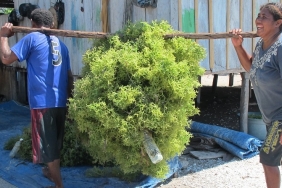BMP ABALONE FARMING
Author: Nur Ahyani (Aquaculture Officer, WWF-Indonesia)
Abalone (Haliotis sp.) is a relatively new commodity developed in Indonesia. The Marine Aquaculture Research and Development Center (BBPPBL) Gondol, Bali and the Marine Aquaculture Fisheries Center (BPBL) Lombok, are examples of two research institutions developing hatchery and rearing technologies for Haliotis squamata and H. asinina..
Abalone farming should be pioneered in Indonesia, given the world market demand for abalone and the declining production of wild-caught abalone. Total world abalone production in 2013 reached 115,692 tons, of which 89% came from cultured abalone products. Currently, China dominates the world's abalone products by operating 300 aquaculture units[i].
So, what about abalone production from aquaculture in Indonesia today? Aquaculture technology in Indonesia is still at the development and trial stage. Production is still done to fulfill the needs of local restaurants. This is partly due to the lack of information on abalone farming technology and knowledge of the abalone market among the public. In fact, Indonesia has the potential to develop abalone farming. Apart from having vast waters, abalone feed can also be produced throughout the year in Indonesia.
To encourage the popularity of abalone farming and support the development of responsible abalone farming in Indonesia, in 2015, WWF-Indonesia published "Better Management Practices (BMP) Abalone (Haliotis sp.) Floating Cage System". It is undeniable that aquaculture is the only way to meet market demand and reduce pressure on nature due to abalone capture. These BMPs were developed through a process of data collection from the field; discussions with experts in abalone aquaculture in Indonesia, including the government; and a literature study of other research results.
The "Abalone Aquaculture BMPs" are flexible, and will continue to be refined in accordance with developments in the field and input from relevant parties. These BMPs are expected to be practically implemented by farmers, which in turn can have a positive impact on the sustainability of the abalone farming business and environmental conservation.
_____________________________
[i] Cook, P.A., 2014. The Worldwide Abalone Industry. Modern Economy, 2014, 5, 1181-1186. Published online December 2014 in SciRes.





